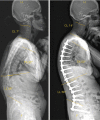Sagittal alignment of the cervical spine: do we know enough for successful surgery?
- PMID: 32309651
- PMCID: PMC7154352
- DOI: 10.21037/jss.2019.11.18
Sagittal alignment of the cervical spine: do we know enough for successful surgery?
Abstract
Over the past decade, there has been growing interest in the sagittal alignment of the cervical spine and its correlation to clinical outcomes. It is now known that cervical lordosis is not universally physiological and should not be pursued in all patients undergoing surgery. Rather, it is increasingly understood that it is how these angular parameters (lordosis or kyphosis) interact with translational parameters that is reflective of overall cervical spine and whole spine balance, which in turn impacts patient outcomes. This review synthesises currently available evidence relating to the sagittal alignment of the cervical spine. Radiographic assessment of the cervical spine including horizontal gaze is discussed and alignment in physiological and pathological states analysed. The interdependence of spinal segments is reviewed, with cervical alignment correction influencing the adjacent thoracic spine, and similarly lumbar lordosis (LL) and global balance correction changing cervical spine alignment. Cervical kyphosis with associated cervical sagittal imbalance is known to lead to poorer post-operative outcomes, and this dichotomy in outcomes has not been shown to improve even with alignment correction. Further work is required to uncover the extent to which cervical spine alignment correction should be attempted toward improved patient outcomes, in order to plan and deliver patient-specific surgical realignment targets.
Keywords: Alignment; cervical spine; corpectomy; discectomy; fusion; kyphosis; laminectomy; laminoplasty; lordosis; sagittal balance; surgery.
2020 Journal of Spine Surgery. All rights reserved.
Conflict of interest statement
Conflicts of Interest: The series “Advanced Techniques in Complex Cervical Spine Surgery” was commissioned by the editorial office without any funding or sponsorship. The authors have no conflicts of interest to declare.
Figures




References
Publication types
LinkOut - more resources
Full Text Sources
Miscellaneous
